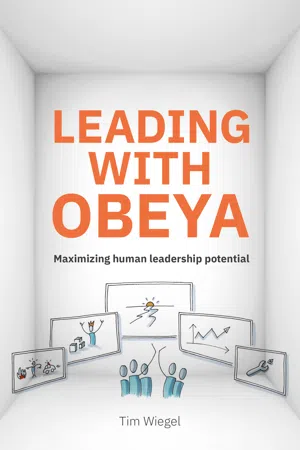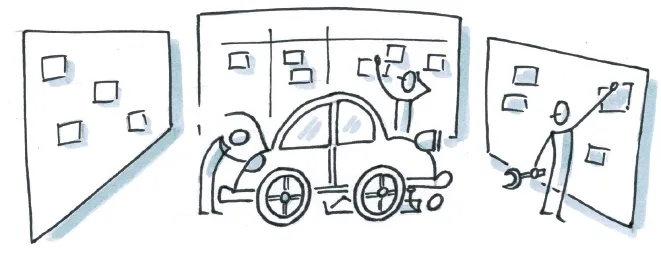![]()
Part I:
Introducing Obeya and the Leadership Reference Model
![]()
This book is for people interested in the development of (their) leadership capabilities in any industry or type of organization. If you are looking to achieve your purpose and achieve your strategic goals through meaningful activities on a daily basis, here is a good place to start.
Though the underlying principles in this book are inspired by Lean* and Agile thinking, our practical approach to explaining them allows you to take the first steps with an Obeya, even if you don’t have a history with Lean or Agile.
But first things first…
What is Obeya?
The word Obeya means “big room” in the Japanese language. Why the Japanese connection? Because that’s where the first “Obeya” originated, at Toyota when building the Prius.
The Obeya functions as a forum for leadership and operational teams to openly, visibly and respectfully engage to make the realization of the organizations strategy part of their day-to-day work. If done well it helps keep out ego-centered politics, confusing prioritization, malfunctioning management practices, misalignment, lack of direction for self-organizing teams and many other types of “traditional management issues.”
WHAT WE CAN LEARN FROM A PRIUS
Toyota put Obeya into practice in 1993 when launching the Prius. Whether you think the car is beautiful or not, Toyota was able to deliver the Prius in about half the time to market compared to many of its competitors, and it became the leading hybrid car in the world. It’s challenge was to double the fuel efficiency of a normal car at the time. The Obeya was setup as the central hub where the team would collaborate over the development of the car.
As Jeff Liker explains in The Toyota Way (2003) about how the Obeya was setup by the Chief Engineer (senior leader) of the Prius project, Takeshi Uchiyamada: “One of the personifications of the chief engineer is that they know everything, so even when developing different parts of the vehicle you know where the bolts can go together as well as what the customer wants. In the old vehicle development system, the chief engineer traveled about, meeting with people as needed to coordinate the program.”
The challenge of the Prius was that it had impossible deadlines and a product that was significantly different than other cars they built. There was simply no time to do it in the old-fashioned way. The team needed to do more in less time and still fulfill the promise of quality that Toyota stands for. “So what could Uchiyamada do, since he did not ‘know everything?’ He surrounded himself with a cross-functional team of experts and relied on them. For the Prius, Uchiyamada gathered a group of experts in the ‘big room’ to review the progress of the program and discuss key decisions.”
Figure 1.1 – Obeya and the Prius, sharing 360 degree context including mechanics and marketing
All the essential management information for the project was gathered in one area. There was one view, one version of the truth of the system to develop and build the Prius, to bring it to the market on time and with double the fuel efficiency.
Workers and managers of different disciplines shared their views of the product and performance visually in one room, creating a strong and meaningful context together. The cross-functional team was seeing, learning and acting together. By working with the prototype car and customer input all in one place, they enabled a focus on customer value and a comprehensive shared understanding with the team on the product to be delivered.
Toyota applied visual management in the context of the Prius project with a focus on the best approach for developing a product. It was an explorative journey, building a totally new type of car in an impossible timeframe. A lot of problems needed to be solved for which there simply was no easy answer, but the team was working with an unprecedented effectiveness.
The Prius was unveiled two months before the intended deadline, which seemed impossible to meet when it was announced to the team, especially for something that had never been done before. Toyota “had met their promise of delivering double the fuel efficiency of a similar gasoline engine car. What’s more, the price tag of ¥2.15 (about 20k USD) million was even lower than what the media had reported back in March.”
Jeff Liker, author of The Toyota Way, explains “The Obeya system has become a standard part of Toyota’s product development system for all vehicles, a fundamental innovation in cross-functional collaboration now copied around the world.” Today, the Prius is not just the best-selling hybrid in the world; in Japan it’s the best-selling car, period.
USING OBEYA TO LEAD AN ORGANIZATION
In this book you will find that we move beyond the concept of Obeya as merely an instrument for visual management and into the realm of leadership in organizations. The reason for this being that teams that transform their classical management activities into a way of working that centers around the Obeya, they go through much more of a change than merely putting visuals on the wall. The change takes place in how a team works, how they interact with their colleagues, when they meet, how they look at their work, their leadership system, how they coach, and many other things that you will find in this book. In potential, starting the journey of leading your organization with Obeya has the potential to be a transformation of the way you look at leadership. When we talk about Obeya for the remainder of this book, we talk about it in this wider context.
The teams using Obeya that I’ve worked with were not building a car. They were not able to inspect the quality of the seats or check how well the glove compartment fit or whether the sound was nice when the door was shut. In fact, many of these organizations were services organizations like banks, public services, telecom or broadcasting. As such, most of the people on the work floor were knowledge workers sitting behind desks with a computer screen. When there is a car prototype right there in the room, you can see it, touch it and feel it, but in the case of knowledge workers it is more difficult as there is no physical representation.
The teams I’ve helped get started with Obeya were leadership teams whose product was not a tangible car, but an intangible object: the achievement of their strategic goals with their operational teams. As such, the Obeya on a leadership level needs help developing strategy and directing efforts towards achieving a purpose almost as tangible as having a car in the middle of the room, you want to connect with what’s happening in your organization. So, in essence, it is an Obeya for leading your organization. I must emphasize straightaway, it is not just for people in a leadership position, but for anyone who contributes towards achieving strategic goals, just as the Prius had a cross-functional team.
The type of information displayed in a Leadership Obeya is usually a representation of the goals (purpose) of the organization, a strategy including customer and stakeholder needs, followed by a definition and outline of how value is delivered and how the organization manages to improve its performance capabilities to deliver that value. Usually, the Obeya is divided into several areas that each have a Rhythm & Routine describing when and how it is used by the leadership team.
Figure 1.2 – Areas in an Obeya to lead an organization
You’ll find many different layouts and setups of Obeyas. Every Obeya will look a bit different depending on who created it and where the team is in their journey (they will adjust the Obeya as they learn ways that work better for them). None is more “correct” than the other, but there are a few recommended ingredients we’ll discuss in detail in Part IV.
Today, the concept of Obeya is being used by organizations around the globe. It has evolved beyond product development to cater to different types of organizations such as Boeing, Ford, Nike and ING Bank. The concept is being adopted by healthcare, industry, financial services and public services. It is a useful way of working for large, international companies, as well as for start-ups and particularly scale-ups, where context sharing is a common challenge.
Obeya was originally used to develop a product (car) in the context of a program. But when we use Obeya to support the leadership function of an organization, it has the potential to align strategy, sharpen focus, share meaningful context and bring about learning and improvement skills for both leadership and operational teams.
“The fixed rhythms providing set topics and meeting frequency provided us with clear purpose and agendas for each meeting. Especially the quick regular updates (15-minute meetings) on problems to be solved and need-to-know things were a big improvement compared to talking about a variety of elements and content that came up during a meeting. The weekly in-depth numbers update helped us create context faster than before when we were drip feeding them in different formats and moments during the week.”
– Pauline van Brakel, Chief Product Officer
OBEYA ISN’T ABOUT THE VISUALS ALONE
Essentially, Obeya for leadership teams aims to unlock the full human leadership potential. The clue in using a visual management tool like Obeya is to cater to (the limitation of) our cognitive senses and introduce a way of working that forms new and desired behaviors through repetition and practice (Kata) to create new effective habits.
From here on we will talk about the use of Obeya in the form of a Leadership Obeya, and when we talk about the “team” it is the team that uses that particular Obeya to achieve their strategic goals. More often than not...


